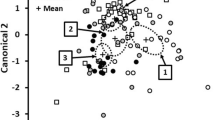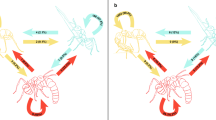Abstract
Reproductive division of labor is a defining feature of all eusocial organisms. In the eusocial insects, non-reproductive labor is often also divided into safe tasks within the nest, such as nursing, and risky extranidal tasks, such as scouting and foraging. Within-nest (intranidal) tasks are usually performed by younger workers while older workers forage outside. This temporal specialization can be delayed, accelerated or even reversed if the need arises. Here, we studied reversion in the clonal ant Platythyrea punctata. Rather than focusing on traditional markers of temporal polyethism, such as nursing vs. foraging, we examined neglected behaviors, such as waste management and defecation, as well as the proportion of ants outside the nest and the onset of egg laying. We formed single-age groups of young intranidal, old intranidal and forager workers, and found strong differences in behavior between these groups. Intranidal workers rapidly created well-formed waste dumps (middens) and defecated within the nest, initiated egg laying sooner, and remained mostly inside the nest. Forager workers showed the reverse pattern. However, the behavior of the groups gradually converged, and after 8 weeks midden formation was similar and the proportion of ants outside the nest was identical across all groups. This study demonstrates reversible temporal polyethism in defecation and waste management, which correlates well with more traditionally studied age-related traits. Different traits seem to revert at different rates. Waste management behavior may provide an easy and low-impact way of examining behavioral reversions and allows insights into aspects of colony life not usually examined.



Similar content being viewed by others
References
Amdam GV, Aase ALTO, Seehuus S-C et al (2005) Social reversal of immunosenescence in honey bee workers. Exp Gerontol 40:939–947. https://doi.org/10.1016/j.exger.2005.08.004
Bates D, Maechler M, Bolker B et al (2015) Fitting linear mixed-effects models using lme4. J Stat Softw 67:1–48. https://doi.org/10.18637/jss.v067.i01
Bernadou A, Busch J, Heinze J (2015) Diversity in identity: behavioral flexibility, dominance, and age polyethism in a clonal ant. Behav Ecol Sociobiol 69:1365–1375. https://doi.org/10.1007/s00265-015-1950-9
Beshers SN, Fewell JH (2001) Models of division of labor in social insects. Annu Rev Entomol 46:413–440. https://doi.org/10.1146/annurev.ento.46.1.413
Beshers SN, Huang ZY, Oono Y et al (2001) Social inhibition and the regulation of temporal polyethism in honey bees. J Theor Biol 213:461–479. https://doi.org/10.1006/jtbi.2001.2427
Brunner E, Kellner K, Heinze J (2009) Policing and dominance behaviour in the parthenogenetic ant Platythyrea punctata. Anim Behav 78:1427–1431. https://doi.org/10.1016/j.anbehav.2009.09.022
Czaczkes TJ, Heinze J, Ruther J (2015) Nest etiquette—where ants Go when nature calls. PLoS One 10:e0118376. https://doi.org/10.1371/journal.pone.0118376
Dolezal AG, Brent CS, Hölldobler B et al (2012) Worker division of labor and endocrine physiology are associated in the harvester ant, Pogonomyrmex californicus. J Exp Biol 215:454–460. https://doi.org/10.1242/jeb.060822
Dolezal AG, Johnson J, Hölldobler B et al (2013) Division of labor is associated with age-independent changes in ovarian activity in Pogonomyrmex californicus harvester ants. J Insect Physiol 59:519–524. https://doi.org/10.1016/j.jinsphys.2013.02.008
Fox J, Weisberg S (2011) An R companion to applied regression, 2nd edn. Sage, Thousand Oaks
Franks NR, Tofts C (1994) Foraging for work: how tasks allocate workers. Anim Behav 48:470–472
Friedman DA, Gordon DM (2016) Ant genetics: reproductive physiology, worker morphology, and behavior. Annu Rev Neurosci 39:41–56. 10.1146/annurev-neuro-070815-013927
Hartmann A, Heinze J (2003) Lay eggs, live longer: division of labor and life span in a clonal ant species. Evolution 57:2424–2429. https://doi.org/10.1554/03-138
Hart AG, Ratnieks FLW (2002) Waste management in the leaf-cutting ant Atta colombica. Behav Ecol 13:224–231. https://doi.org/10.1093/beheco/13.2.224
Herb BR, Wolschin F, Hansen KD et al (2012) Reversible switching between epigenetic states in honeybee behavioral subcastes. Nat Neurosci 15:1371–1373. https://doi.org/10.1101/gr.154187.112
Heinze J, Hölldobler B (1995) Thelytokous parthenogenesis and dominance hierarchies in the ponerine ant, Platythyrea punctata. Naturwissenschaften 82:40–41. https://doi.org/10.1007/BF01167871
Hölldobler B, Wilson EO (2009) The super-organism: the beauty, elegance, and strangeness of insect societies, 1st edn. W. W. Norton & Co, New York
Johnson BR (2010) Division of labor in honeybees: form, function, and proximate mechanisms. Behav Ecol Sociobiol 64:305–316
Korczyńska J, Szczuka A, Symonowicz B et al (2014) The effects of age and past and present behavioral specialization on behavior of workers of the red wood ant Formica polyctena Först during nestmate reunion tests. Behav Proc 107:29–41. https://doi.org/10.1016/j.beproc.2014.07.009
Kuszewska K, Woyciechowski M (2013) Reversion in honeybee, Apis mellifera, workers with different life expectancies. Anim Behav 85:247–253. https://doi.org/10.1016/j.anbehav.2012.10.033
Mersch DP, Crespi A, Keller L (2013) Tracking individuals shows spatial fidelity is a key regulator of ant social organization. Science 340:1090–1093. https://doi.org/10.1126/science.1234316
Mikheyev AS, Linksvayer TA (2015) Genes associated with ant social behavior show distinct transcriptional and evolutionary patterns. eLife 4:e04775. https://doi.org/10.7554/eLife.04775
Münch D, Amdam GV (2010) The curious case of aging plasticity in honey bees. FEBS Lett 584:2496–2503. https://doi.org/10.1016/j.febslet.2010.04.007
Münch D, Amdam GV, Wolschin F (2008) Ageing in a eusocial insect: molecular and physiological characteristics of life span plasticity in the honey bee. Funct Ecol 22:407–421. https://doi.org/10.1111/j.1365-2435.2008.01419.x
Muscedere ML, Willey TA, Traniello JFA (2009) Age and task efficiency in the ant Pheidole dentata: young minor workers are not specialist nurses. Anim Behav 77:911–918. https://doi.org/10.1016/j.anbehav.2008.12.018
Norman VC, Hughes WO (2016) Behavioural effects of juvenile hormone and their influence on division of labour in leaf-cutting ant societies. J Exp Biol 219:8–11. https://doi.org/10.1242/jeb.132803
Oster GF, Wilson EO (1978) Caste and ecology in the social insects. Princeton University Press, Princeton
Penick CA, Liebig J, Brent CS (2011) Reproduction, dominance, and caste: endocrine profiles of queens and workers of the ant Harpegnathos saltator. J Comp Physiol A 197:1063–1071. https://doi.org/10.1007/s00359-011-0667-0
R Development Core Team (2015) R: a language and environment for statistical computing. R Foundation for Statistical Computing, Vienna
Robinson GE (1992) Regulation of division of labor in insect societies. Annu Rev Entomol 37:637–665. https://doi.org/10.1146/annurev.en.37.010192.003225
Robinson GE, Page RE, Strambi C et al (1992) Colony integration in honey bees: mechanisms of behavioral reversion. Ethology 90:336–348. https://doi.org/10.1111/j.1439-0310.1992.tb00844.x
Seeley TD (1982) Adaptive significance of the age polyethism schedule in honeybee colonies. Behav Ecol Sociobiol 11:287–293. https://doi.org/10.1007/BF00299306
Seid MA, Traniello JFA (2006) Age-related repertoire expansion and division of labor in Pheidole dentata (Hymenoptera: Formicidae): a new perspective on temporal polyethism and behavioral plasticity in ants. Behav Ecol Sociobiol 60:631–644. https://doi.org/10.1007/s00265-006-0207-z
Smith CR, Toth AL, Suarez AV et al (2008) Genetic and genomic analyses of the division of labour in insect societies. Nat Rev Genet 9:735–748. https://doi.org/10.1038/nrg2429
Symonowicz B, Kieruzel M, Szczuka A et al (2015) Behavioral reversion and dark–light choice behavior in workers of the red wood ant Formica polyctena. J Insect Behav 28:245–256. https://doi.org/10.1007/s10905-015-9496-2
Tofilski A (2009) Shorter-lived workers start foraging earlier. Insect Soc 56:359–366. https://doi.org/10.1007/s00040-009-0031-3
Tofts C, Franks NR (1992) Doing the right thing: ants, honeybees and naked mole-rats. Trends Ecol Evol 7:346–349. https://doi.org/10.1016/0169-5347(92)90128-X
Wilson EO (1971) The insect societies. Harvard University Press, Cambridge
Wilson EO (1976) Behavioral discretization and the number of castes in an ant species. Behav Ecol Sociobiol 1:141–154. https://doi.org/10.1007/BF00299195
Wnuk A, Wiater M, Godzińska EJ (2011) Effect of past and present behavioural specialization on brain levels of biogenic amines in workers of the red wood ant Formica polyctena. Physiol Entomol 36:54–61. https://doi.org/10.1111/j.1365-3032.2010.00762.x
Woyciechowski M, Kozłowski J (1998) Division of labor by division of risk according to worker life expectancy in the honeybee (Apis mellifera L.). Apidologie 29:191–205. https://doi.org/10.1051/apido:19980111
Zuur A, Ieno EN, Walker N et al (2009) Mixed effects models and extensions in ecology with R. Springer, New York
Acknowledgements
The study was supported by DFG (He 1623/33). TC was funded by an Alexander von Humboldt fellowship. Thanks to Patrycya Owczarska for help with data collection. We thank Bartosz Walter, Marion Füßl, Tina Wanke, Katrin Kellner and Jon N. Seal for help collecting the ants, Bartosz Walter and Bert Rivera Marchand for help with obtaining permits. Research in Puerto Rico was permitted by USDA Forest Service and Departamento de Recursos Naturales y Ambientales, 2012-IC-036. We thank anonymous reviewers and Stephen Pratt for comments on earlier versions of this manuscript.
Author information
Authors and Affiliations
Corresponding author
Rights and permissions
About this article
Cite this article
Bernadou, A., Czaczkes, T.J. & Heinze, J. From inside to outside and back again: changing waste dump formation, defecation and worker localization in a clonal ant. Insect. Soc. 65, 133–140 (2018). https://doi.org/10.1007/s00040-017-0594-3
Received:
Revised:
Accepted:
Published:
Issue Date:
DOI: https://doi.org/10.1007/s00040-017-0594-3




